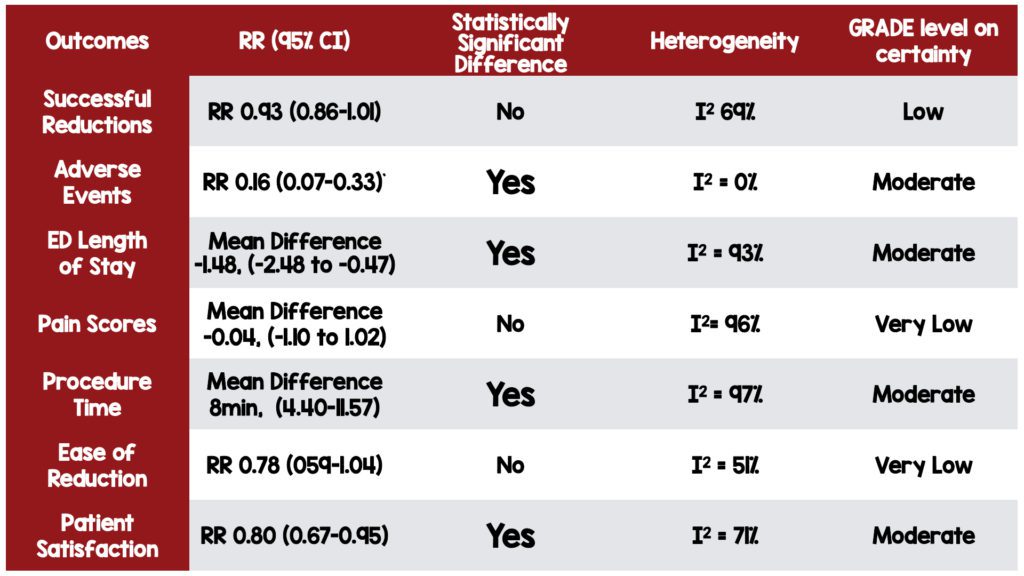
 Background: Many clinicians have transitioned from procedural sedation and analgesia (PSA) in favor of intra-articular lidocaine (IAL) to manage anterior shoulder dislocation. PSA, also referred to as intravenous sedation in this paper, requires considerable resources, including 1:1 nursing observation, and burdens the emergency department (ED). In addition, many hospitals are still reeling from the COVID-19 pandemic and face crippling staff shortages, and sparing a nurse for PSA will be difficult. Therefore, clinicians must arm themselves with multiple approaches to solve complex problems as there often is no one-size fits all solution. This systematic review and meta-analysis compares the efficacy of IAL to PSA and provides a pooled estimate of previous RCTs for managing acute anterior shoulder dislocation.
Background: Many clinicians have transitioned from procedural sedation and analgesia (PSA) in favor of intra-articular lidocaine (IAL) to manage anterior shoulder dislocation. PSA, also referred to as intravenous sedation in this paper, requires considerable resources, including 1:1 nursing observation, and burdens the emergency department (ED). In addition, many hospitals are still reeling from the COVID-19 pandemic and face crippling staff shortages, and sparing a nurse for PSA will be difficult. Therefore, clinicians must arm themselves with multiple approaches to solve complex problems as there often is no one-size fits all solution. This systematic review and meta-analysis compares the efficacy of IAL to PSA and provides a pooled estimate of previous RCTs for managing acute anterior shoulder dislocation.
Paper: Sithamparapillai A, Grewal K, Thompson C, Walsh C, McLeod S. Intra-articular lidocaine versus intravenous sedation for closed reduction of acute anterior shoulder dislocation in the emergency department: a systematic review and meta-analysis [published online ahead of print, 2022 Oct 1]. CJEM. 2022;1-11. PMID: 36181665
Clinical Question: In patients with acute anterior shoulder dislocations, how does IAL compare to PSA for closed reduction?
What They Did:
- Used a medical librarian to search for randomized control trials of the following databases: PubMed, OVID, EMBASE, Cochrane Central Register of Controlled Trials, ClinicalTrials.gov, and electronic bibliographic databases up to Sep 2021.
- Data were extracted by one researcher and verified by another.
- Trials were assessed independently by two peer reviewers for potentially eligible clinical trials. A third reviewer adjudicated discrepancies when necessary.
- Researchers contacted authors of RCT trials for additional information and access to raw data when required.
- Used the Cochrane Collaboration’s tool for assessing the risk of bias for systematic reviews of interventions
- Utilization of the GRADE approach to provide a structured and transparent method for assessing the quality of evidence.
Inclusion Criteria:
- RCTs comparing IAL to PSA with any agent for closed reduction of acute anterior shoulder dislocation for patients > 15 years of age
Exclusion Criteria:
- Studies involving only pediatric population
- Posterior shoulder dislocation
- Fracture-dislocations
- Settings outside the ED
Outcomes:
Primary
- Successful Reduction
Secondary
- Adverse events
- Length of ED stay
- Pain score post-anesthesia and pre-reduction
- Pain score pre-anesthesia and post-reduction
- Procedure time for reduction only
- Ease of reduction
- Patient satisfaction
- Cost
Results:
-
554 citations were obtained after the initial search
- 483 citations were excluded for incorrect design, intervention, or topic
- 48 duplicate citations excluded
- 23 citations selected for full-text review
-
12 RCTs were included with a total of 630 patients
- 327 patients in the intra-articular lidocaine group
- 303 patients in the PSA group
- All studies published between 1994 and 2020 involved ED populations from 6 countries with ages ranging from 16-89
Critical Results:

-
No difference in reduction success between IAL and PSA.
(83.8% vs. 91.4%; RR 0.93; 95% CI 0.86–1.01, I2 = 69%, low certainty) -
Fewer adverse events occurred in the IAL group compared to the PSA group.
(1.3% vs. 20.8%; RR 0.16; 95% CI 0.07–0.33, I2 = 0, moderate certainty) -
Mean ED length of stay was signifficantly shorter in the IAL group compared to the PSA group.
(mean difference = − 1.48 h; 95% CI − 2.48 to − 0.47, I2 = 93%, moderate certainty) -
No difference in pain score after anesthesia and before reduction in the IAL group compared to the PSA group.
(mean difference = − 0.04; 95% CI − 1.10 to 1.02, I2 = 96%, very low certainty) -
Procedural time was significantly longer in the IAL group compared to PSA
(mean difference = 8 min; 95% CI 4.42–11.57, I2 = 97%, moderate certainty) -
No statistically significant difference in ease of reduction in the IAL group compared to PSA.
(54.5% vs. 71.8%; RR 0.78; 95% CI 0.59–1.04, I2 = 51%, very low certainty) -
Patient satisfaction was significantly decreased in the IAL group compared to PSA.
(70.5% vs. 90.4%; RR 0.80; 95% CI 0.67–0.95, I2 = 71%, moderate certainty)
Strength:
- Comprehensive search of multiple databases and independent duplicate assessment of eligibility
- Contacted authors of the included study for additional information when necessary
- Only included RCTs in analysis which provides the highest quality of evidence
- Weighting of included RCTs distributed fairly evenly. No paper carried more than 12.6% weight of the entire meta-analysis, and 9/12 carried more than 8% weight.
- Included studies from 6 different countries
- Utilization of the GRADE approach to provide a structured and transparent method for assessing the quality of evidence
- Used Cochrane Bias Assessment tool
- Structured tool for data extraction with an approach to resolving discrepancies
- Addresses clinically relevant questions regarding procedural pain management in the ED
Limitations:
- Small sample size for many of the investigated outcomes
- Strict inclusion criteria: only anterior shoulder dislocation included, no indication regarding initial vs repeated dislocations
- Lack of information on patient characteristics and comorbidities
- Some secondary outcomes were not patient-centered
- PSA groups received different combinations of medications, including anxiolytics, analgesics, or sedatives.
- No standardization of dosing regimens.
- No information on the number of attempts required to obtain a successful reduction
- No information on techniques utilized
- No information on background or the skill of the provider and familiarity with the procedure
- Moderate to large amount of heterogeneity among all but two outcomes in pooled studies
- No interrater reliability discussed for data extraction
- Risk of bias for blinding is high, which may influence the outcomes in the individual studies
Discussion:
-
Patients in the IAL group:
- On average spent 1.48 hours less in the ED.
- Experienced 175 fever adverse events per 1000 patients.
- Experienced no difference in pain scores compared to the PSA cohort.
- IAL performed worse than PSA in patient satisfaction, procedure time, and ease of reduction. It’s not surprising patients are less satisfied with IAL. The anxiety and fear in patients with joint dislocations may be difficult to overcome completely with IAL. However, when considering the adverse effects of sedation, including hypoxia and decreased ventilation, clinicians would likely prefer decreased adverse events and quicker throughput times in the ED at the expense of increased procedure times, slightly more difficult reduction, and worse patient satisfaction scores.
- Heterogeneity (I2) for the primary outcome was 69%, representing a moderate value. When heterogeneity is low, we are comfortable that data from the included trials are similar enough to form a pooled estimate. As heterogeneity increases, we become more uncomfortable combining the data to form a pooled estimate.
- Patients in the different trials received various medications and dosing regimes. Different agents have vastly different pharmacologic profiles, onset and duration of action, analgesic effects, and adverse/side effects. Likewise, higher doses of medicines may affect success rates and duration of sedation. Moreover, there is no information on the technique used for reduction, provide skill level, and number of attempts. The information likely has a vital impact on the success of any individual attempt.
- By nature of the trial and individual study objective, the individual studies could not be blinded. Of particular note, subjective outcomes are particularly prone to bias in an open-label trial. Objective measures such as number of attempts are less prone to bias than ease of reduction.
Author’s Conclusions: “Intra-articular lidocaine may have similar effectiveness as IV sedation in the successful reduction of anterior shoulder dislocations in the ED with fewer adverse events, shorter ED length of stay, and no difference in pain scores or ease of reduction. Intra-articular lidocaine may be an effective alternative to IV sedation for reducing anterior shoulder dislocations, particularly when IV sedation is contraindicated or not feasible.”
Our Conclusion:
We agree with the author’s conclusion. While this systematic review and meta-analysis has flaws, the data provided are provocative. IAL is a safe and effective alternative for anterior shoulder dislocation reduction in the ED with little downside.
Clinical Bottom Line:
Consider IAL for closed reduction of anterior shoulder dislocation.
References:
- Brady WJ, Knuth CJ, Pirrallo RG. Bilateral inferior glenohumeral dislocation: luxatio erecta, an unusual presentation of a rare disorder. J Emerg Med. 1995 Jan-Feb;13(1):37-42. doi: 10.1016/0736-4679(94)00110-3. PMID: 7782623.
- Sithamparapillai, A, Grewal, K,Thompson, C, Walsh, C, McLeod, S. Intra-Articular lidocaine versus intravenous sedation for closed reduction of acute anterior shoulder dislocation in the Emergency Department: a systematic review and meta-analysis. Canadian Journal of Emergency medicine. October 2022. PMID: 36181665
Guest Post By:

Nordia Matthews, MD
PGY-1, Emergency Medicine Resident
Vassar Brothers Hospital, Poughkeepsie, New York
E-mail: nordia.matthews@nuvancehealth.org
Marco Propersi, DO FAAEM
Vice-Chair, Emergency Medicine
Vassar Brothers Hospital, Poughkeepsie, New York
Twitter: @marco_propersi
Post-Peer Reviewed By: Salim R. Rezaie, MD (Twitter: @srrezaie)
The post Intra-articular Lidocaine vs Procedural Sedation and Analgesia for Closed Reduction of Acute Anterior Shoulder Dislocation appeared first on REBEL EM - Emergency Medicine Blog.
